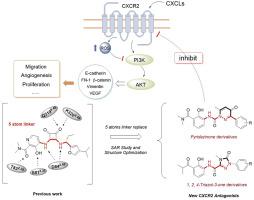European Journal of Medicinal Chemistry ( IF 6.0 ) Pub Date : 2021-09-09 , DOI: 10.1016/j.ejmech.2021.113812 Xun Zhang 1 , Jingyi Luo 1 , Qinyuan Li 2 , Qilei Xin 1 , Lizhen Ye 1 , Qingyun Zhu 3 , Zhichao Shi 1 , Feng Zhan 1 , Bizhu Chu 4 , Zijian Liu 5 , Yuyang Jiang 6

|
Chemokine receptor 2 (CXCR2) is the receptor of glutamic acid–leucine–arginine sequence-contained chemokines CXCs (ELR+ CXCs). In recent years, CXCR2-target treatment strategy has come a long way in cancer therapy. CXCR2 antagonists could block CXCLs/CXCR2 axis, and are widely used in regulating immune cell migration, tumor metastasis, apoptosis and angiogenesis. Herein, two series of new CXCR2 small-molecule inhibitors, including 1,2,4-triazol-3-one derivatives 1–11 and pyridazinone derivatives 12–22 were designed and synthesized based on the proof-to-concept. The pyridazinone derivative 18 exhibited good CXCR2 antagonistic activity (69.4 ± 10.5 %Inh at 10 μM) and demonstrated its significant anticancer metastasis activity in MDA-MB-231 cells and remarkable anti-angiogenesis activity in HUVECs. Furthermore, noteworthy was that 18 exhibited an obvious synergistic effect with Sorafenib in anti-proliferation assay in MDA-MB-231 cells. Moreover, 18 showed a distinct reduction of the phosphorylation levels of both PI3K and AKT proteins in MDA-MB-231 cells, and also affected the expression levels of other PI3K/AKT signaling pathway-associated proteins. The molecular docking studies of 18 with CXCR2 also verified the rationality of our design strategy. All of these results revealed pyridazinone derivative 18 as a promising CXCR2 antagonist for future cancer therapy.
中文翻译:

作为新型 CXCR2 拮抗剂的 1,2,4-triazol-3-one 衍生物和哒嗪酮衍生物的设计、合成和抗肿瘤评价
趋化因子受体 2 (CXCR2) 是含有谷氨酸-亮氨酸-精氨酸序列的趋化因子 CXCs (ELR + CXCs) 的受体。近年来,CXCR2靶向治疗策略在癌症治疗中取得了长足的进步。CXCR2拮抗剂可阻断CXCLs/CXCR2轴,广泛用于调节免疫细胞迁移、肿瘤转移、细胞凋亡和血管生成。在此,基于概念验证设计和合成了两个系列的新型CXCR2小分子抑制剂,包括 1,2,4-triazol-3-one 衍生物1-11和哒嗪酮衍生物12-22 。哒嗪酮衍生物18表现出良好的 CXCR2 拮抗活性(10 μM 时为 69.4 ± 10.5 %Inh),并在 MDA-MB-231 细胞中表现出显着的抗癌转移活性,在 HUVEC 中表现出显着的抗血管生成活性。此外,值得注意的是,18在MDA-MB-231细胞的抗增殖试验中与索拉非尼表现出明显的协同作用。此外,18显示 MDA-MB-231 细胞中 PI3K 和 AKT 蛋白的磷酸化水平明显降低,并且还影响了其他 PI3K/AKT 信号通路相关蛋白的表达水平。18与CXCR2的分子对接研究也验证了我们设计策略的合理性。所有这些结果都揭示了哒嗪酮衍生物18作为未来癌症治疗的有前途的 CXCR2 拮抗剂。











































 京公网安备 11010802027423号
京公网安备 11010802027423号